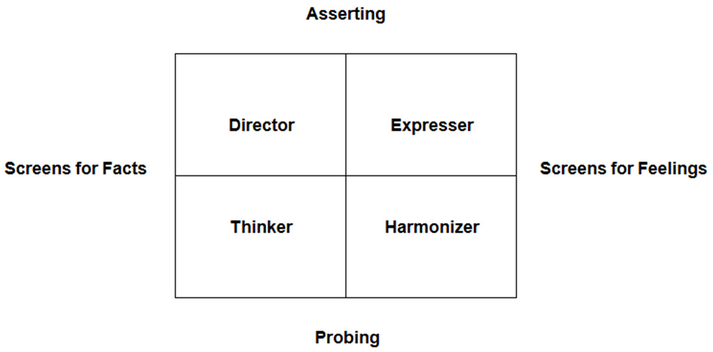
The Role of Attention
To become proficient in identifying other people’s styles, you need to understand how communication styles work.
 Of the nearly infinite things we could be aware of at any one time we focus on only a few. At the center of this selection process sits our attention.
Of the nearly infinite things we could be aware of at any one time we focus on only a few. At the center of this selection process sits our attention.
It is the roving lens of the mind, constantly scouring the environment and choosing in a nanosecond which things to concentrate on.
For example, when you walk down the street, do you pay attention to the buildings or focus on people’s faces? In a restaurant, do you get engrossed in the menu or observe the people in the room? In a meeting, do you pay attention to people’s remarks or think about what you’re going to say?
Attentions differ, which dramatically alters the way people see and respond to the exact same situation.
This is an important point. Because if one person pays attention to people and another to buildings, or if one person focuses on tasks while another focuses on feelings, their conversations have the potential to misfire.
Although they’re sitting in the same room or discussing the same topic, they’ll interpret what they’re hearing in radically different ways and draw very different conclusions.
If If they don’t recognize and acknowledge their different ways of thinking, their communications will whiz by each other with little chance for a connection.
 In our work with organizations, we’ve studied these different styles. We know that some people approach a decision wanting to get as much data as possible. Others make decisions swiftly. Still others want to generate as many ideas as possible.
In our work with organizations, we’ve studied these different styles. We know that some people approach a decision wanting to get as much data as possible. Others make decisions swiftly. Still others want to generate as many ideas as possible.
In case after case, we found that people can communicate far more effectively once they understand their different styles.
Putting These Skills To Use
The parent company of a Midwestern advertising agency hired us to help turn the agency around. The CEO wasn’t meeting revenue goals. More important, there were rumors that the three top account representatives were about to leave and start their own firm. Armed with that limited background, we flew to meet the CEO in person and get a sense of things.
We arrived a bit early, and while we sipped coffee in the first floor reception area we focused on the room’s decor. The walls were a bright shade of blue, with photographs of the agency’s personnel hanging on one wall. A trophy case filled another wall. In the corner a television was on.
A secretary ushered us in past desks that were mostly empty to the CEO’s office. As we walked through the room, we could see people in twos and threes clustered around desks in the back of the room. We couldn’t hear what they were saying, but the conversations seemed pretty lively. People were laughing and having a good time.
Dan, the CEO, met us with a warm handshake and asked us to sit down. He immediately launched into a description of a new radio campaign he was planning. He spoke very rapidly about the prospects of attracting younger buyers, a key concern for this particular client of his.
We asked a couple of questions about his agency, and he told us that everything was going great. Ratings had never been better, the staff was “on fire” and the competition was “getting creamed.”
We asked why he thought the parent company had called us in.
Dan took off his glasses and moved around to the front edge of his desk. He punctuated his comments by jabbing at us with his glasses.
“Our parent company wanted us to use you, and so you’re here. We think it’s probably a pretty good idea to take stock. But we’ve got a great team here, and everything’s going great. We’ve got a few problems in a few departments, and one department has some problems, but we’ve never been better, and we’re really looking forward to this next year.”
Stop here, and ask yourself what style of communicator we were dealing with. If you said “Expresser,” you’re absolutely right. Dan’s rapid fire delivery, his disjointed stream of logic, his gesturing with his glasses were all clues. So we responded with the following:
“One of the things we perceive in general about business,” I said, “is how disorganized things can get. Especially in your type of business, where people are so focused on juggling multiple clients and deadlines. People aren’t clear on the bigger goals, managers don’t set priorities, people invent a million ideas but they don’t have time to take one and execute it carefully.
“We can help your organization learn how to discipline itself to do things in a more carefully thought out manner. The result will be better performance.”
“I guess corporate spelled it out for you pretty well. You’ve got a good handle on our problems here.”
“Actually,” I said, “we didn’t get it from corporate. That comes from picking up clues in the 20 minutes since we got here. It’s a bit of a lucky guess. But we knew what to look for.”
To Dan, what seemed like magic was simply the result of analyzing his communication style and knowing its likely impact on the organization. All it took was using the tools – and a little observation.
| Lesson 11: Communication Styles in Business | Lesson 13: The Circle of Assumptions |
2 Comments
Add yours+ Leave a Comment
You must be logged in to post a comment.


[…] Lesson 12: The Role of Attention […]
[…] Lesson 12: The Role of Attention […]